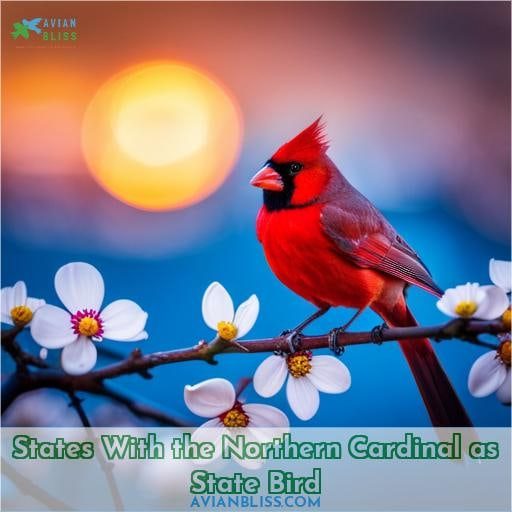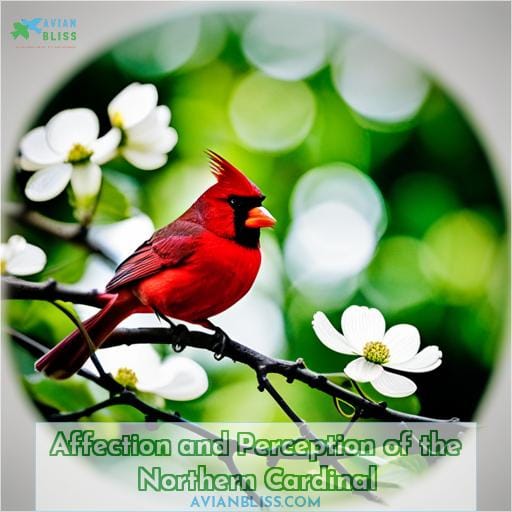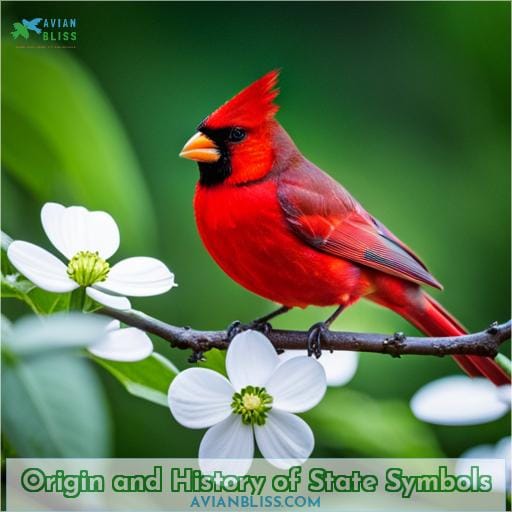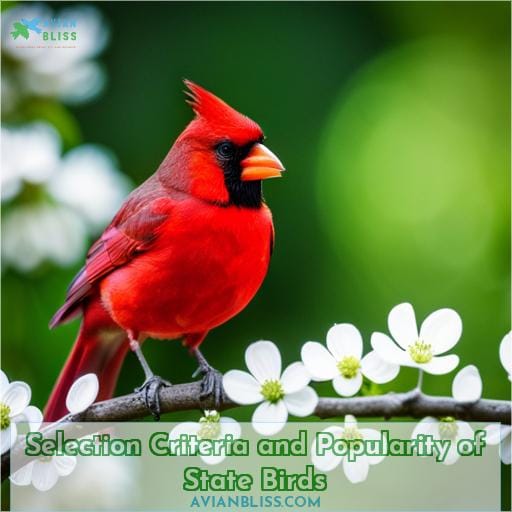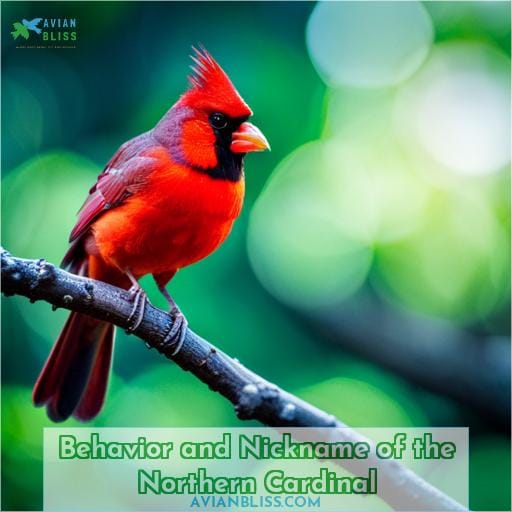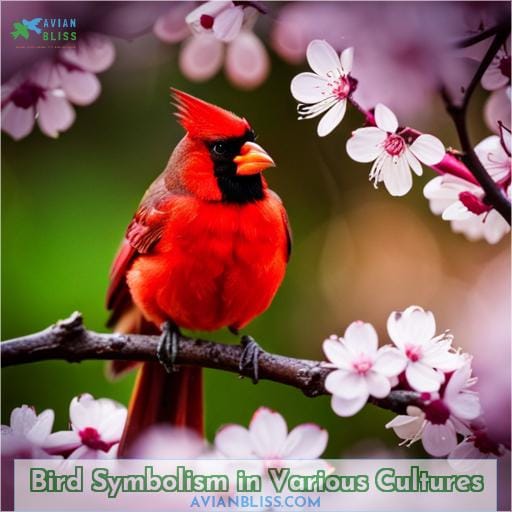This site is supported by our readers. We may earn a commission, at no cost to you, if you purchase through links.
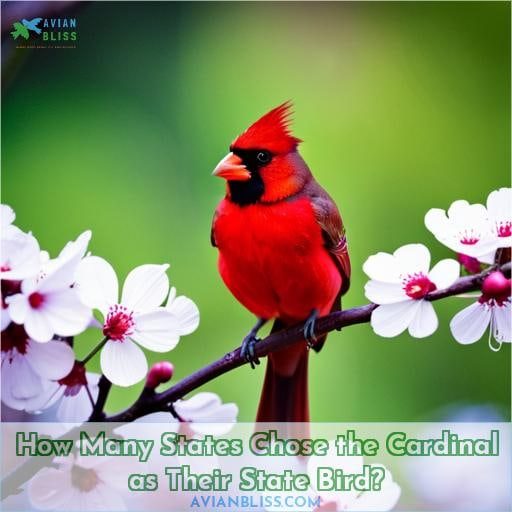 Did you know some states share the same avian emblem? Seven states actually chose the northern cardinal as their official state bird.
Did you know some states share the same avian emblem? Seven states actually chose the northern cardinal as their official state bird.
You might be familiar with this bright red songbird – it’s one of the most common backyard birds in the eastern U.S. The northern cardinal’s vibrant color and whistling song have made it a favorite among birdwatchers.
Its selection illustrates the unique way states represent their identity and heritage through symbols like state birds.
This article will cover which states picked the sociable, iconic cardinal and the history behind how states select these meaningful symbols. We’ll also explore characteristics that make the northern cardinal a popular choice, as well as other state birds that reflect an area’s spirit.
Understanding state symbols offers a glimpse into what makes each place special – keep an eye out for your feathered state pride next time you’re birding!
Table Of Contents
- Key Takeaways
- Significance of the Northern Cardinal as State Bird
- States With the Northern Cardinal as State Bird
- Characteristics and Symbolism of the Northern Cardinal
- Affection and Perception of the Northern Cardinal
- Origin and History of State Symbols
- Selection Criteria and Popularity of State Birds
- Behavior and Nickname of the Northern Cardinal
- Historical Context and Impact of State Birds
- Bird Symbolism in Various Cultures
- Other State Birds and Their Importance
- Frequently Asked Questions (FAQs)
- How did the cardinal get its name?
- What are some interesting facts about the cardinal’s nesting habits?
- What is the cardinal’s migratory pattern? Do they stay in one area year-round?
- What are some of the cardinal’s vocalizations besides its distinctive song?
- How long is the average lifespan of a cardinal in the wild?
- Conclusion
Key Takeaways
- The Northern cardinal is the official state bird in 7 states.
- Symbolic significance of the Northern cardinal includes representing state identity and heritage, as well as hope, joy, and pride.
- The physical characteristics of the Northern cardinal include distinct male and female plumage, with males being bright red and females having muted colors.
- The Northern cardinal holds symbolism in various cultures and is seen as a messenger and symbol of the soul.
Significance of the Northern Cardinal as State Bird
Your attention to the cardinal’s song enlivens the spirit. The Northern Cardinal’s vivid appearance and territorial behavior reflect its cultural importance as a symbol of state pride for seven states.
Its distinctive crest and coloration hold symbolic significance, representing hope and joy.
Like the mountain bluebird in Idaho and Nevada or the northern mockingbird in Arkansas and Tennessee, the cardinal instills pride in its origin state. Yet beyond mere state symbolism, this bird’s cultural importance traces back centuries, with its image woven into the fabric of numerous societies.
Ultimately, the cardinal represents far more than a state bird – its voice sings of belonging, its color embodies human understanding, and its reflection reveals our shared desire for mastery.
States With the Northern Cardinal as State Bird
The Northern Cardinal proudly serves as the state bird for seven states across the American South and Midwest: Illinois, Indiana, Kentucky, North Carolina, Ohio, Virginia, and West Virginia. With its brilliant red plumage and distinctive crest, this bird’s vibrant beauty echoes your own bright, joyful spirit.
Illinois
You’ll be intrigued to learn that Illinois chose the striking Northern Cardinal as its official state bird. The cardinal’s vibrant coloration resonates with Illinoisans, reminding them of their prairie state’s landscapes and heartland warmth.
This iconic songbird joins the state’s other beloved symbols like the oak tree and purple violet in representing Illinois pride.
Indiana
Indiana’s cardinal blazes crimson through your soul, radiating the spirit of the Hoosier state. As winter population declines impact this cultural symbol, you rally to deploy more feeders and limit hunting seasons.
With ongoing habitat loss, the cardinal’s winter red flashes bring concern but also hope – hope that conservation initiatives preserve the state bird’s future in Indiana.
Kentucky
Kentucky’s lively cardinal will make your heart sing with its charming red feathers and whistling songs. This spirited songbird symbolizes the Bluegrass State with its scarlet plumage and familiar melodies.
Watch for its swooping, undulating flight during migrations. Pairs nest in dense shrubs, fiercely defending eggs. Poems laud its beauty; books explore symbolism. Yet its coral-colored beak hints at a fiery temper, attacking mirrors or windows.
Still, Kentuckians embrace their state bird, the cardinal, despite its feisty streak.
North Carolina
Your Northern Cardinal reminds us of home as North Carolina’s distinctive state bird. This fiery red songbird embodies Carolina pride, uniting fans of rival collegiate teams across the state’s Piedmont Plateau and Outer Banks beaches.
With origins tracing back to North Carolina’s history as a furniture manufacturing hub and Tobacco Road, the cardinal represents our collective identity. Though other birds like the American Robin and Chickadee populate our state, the Northern Cardinal truly symbolizes our heritage.
Ohio
Ohio has its cardinal, a beloved bright beauty that boosts the state’s pride. This red-feathered songbird delights birdwatchers, who flock to catch a glimpse of its annual migration. Surviving winter through resilience and adaptability, Ohio embraced the northern cardinal as its official state bird for its symbolism of hope and perseverance.
Representing the shared identity of Ohioans, the cardinal’s cheerful chirps and scarlet plumage kindle a sense of belonging.
Virginia
You’re lucky to call Virginia home with its majestic Northern Cardinal singing joyfully as your cherished state bird. Its crisp red plumage and tree-dotted habitat make Virginia’s landscapes picturesque, while its spirited songs are anthem-inspiring.
This slogan-worthy bird’s prevalence reflects your state’s deep pride in its origins.
West Virginia
WV’s Bird of Paradise illuminates the heart of Almost Heaven.
The Northern Cardinal has special meaning for West Virginians as their official state bird.
- Hope
- Joy
- Vitality
- Pride in roots
- Appreciation of nature
The cardinal’s familiar chirps and flashes of red bring cheer year-round, reminding residents of the beauty found in the Mountain State.
Characteristics and Symbolism of the Northern Cardinal
The brilliant red plumage and striking black masks of male Northern Cardinals and their more muted brown female counterparts soar through our backyards, lifting our spirits with hope, joy, health, and rejuvenation.
Northern Cardinals, long associated with human affinity, emerge as a powerful positive symbol for the seven U.
Vibrant Coloration
Your bright red plumage catches the eye as you flit through the trees. Cardinal enthusiasts admire your vibrant coloration, a symbol of hope and pride. Your song rings out loudly, grabbing attention with its punchy tones. Vibrant males perform courtship displays, seeking the perfect mate.
Females carefully inspect each male, ultimately selecting the boldest red and richest song.
Distinct Male/female Differences
The bright red male and muted brown female add a beautiful gender dynamic. You’ll observe the striking plumage variation between genders, from the male’s fiery crest and black face mask to the female’s soft tan and gray tones.
Even their songs differ, with the males’ loud whistles used to defend territory. Seasonal migration and nesting bring out intriguing diet and nest architecture differences.
Symbolizes Hope, Joy, Health, and Rejuvenation
What a comforting thought, girl, knowing this crimson beauty brings hope and joy to so many. It makes me want to throw open the windows and let its cheer-filled song in! The cardinal’s rich symbolism resonates deeply, captivating hearts.
Hope inspires, joy uplifts, and health rejuvenates – the cardinal’s essence rings true.
Affection and Perception of the Northern Cardinal
The Northern Cardinal’s vibrant plumage and spirited song reflect a feisty personality that many find endearing. This affection shines in the words of Victoria McGovern, who describes the cardinal as a splash of bright color that brings joy on a winter day.
Reflects Special Personality Traits
You’re instantly drawn to the cardinal’s vibrance, eliciting a fondness that resonates deeply. The cardinal’s personality emanates through its biological uniqueness, from its crest to its winter color.
Behavioral study suggests spiritual reasoning behind the territoriality and reflective attacks – mental attributes we subconsciously admire.
Fosters Affection Among Bird Enthusiasts
You’d be hard-pressed not to smile when that bright red bird starts singing its cheerful song outside your window. The Northern Cardinal’s vibrant plumage and melodious tunes foster affection among birdwatchers and nature lovers alike.
- Cardinals represent resilience and motivate conservation efforts.
- Their pride in home territory empowers state symbolism.
- Insufficient research limits full understanding of their complex behaviors.
The Northern Cardinal’s lively spirit brings joy to many. Its distinctive traits inspire appreciation and affection from bird enthusiasts across its range.
Quote Highlighting the Cardinal’s Positive Impact
You’ll adore the Northern Cardinal’s cheery chirps and vivid red plumage, with seven states selecting it as their avian emblem. Victoria McGovern captures the cardinal’s uplifting essence, saying, A cardinal is a representative of a loved one who passed.
When you see one, it means they are visiting you. They usually show up when you most need them or miss them. The cardinal’s visits are inspiring events, bringing vitality, hope, and health.
Origin and History of State Symbols
Let’s delve into the origin and history of state symbols. Back in 1893, the National Garland of Flowers initiated the concept of states adopting representative plants and animals. Since then, each state has chosen unique symbols that reflect local pride and identity.
Northern Cardinals, in particular, represent several states, connecting people across regions through a common appreciation.
National Garland of Flowers in 1893
Twas the National Garland of Flowers in 1893 that first planted the seed of adopting unique state symbols like birds, igniting a sense of pride in one’s home state. Each state’s designated avian embodies distinctive traits, from the cardinal’s vibrant plumage to the mockingbird’s rich repertoire, reminding citizens of their distinctive origins.
Birds like the cardinal reflect a lifecycle and patterns intertwined with their adopted state’s landscape and history, migration woven into the seasonal changes.
Uniqueness and Pride in Origin
You’re so proud of your home state’s unique bird that you’d shout its name from the highest mountain.
- The cardinal’s red plumage reflects your state’s bold spirit.
- Its melodious song echoes your community’s rich heritage.
- Its resilience through winter symbolizes your state’s perseverance.
The cardinal stirs a sense of origin and belonging, bonding your community through a shared identity.
Selection Criteria and Popularity of State Birds
Your heart swells with cardinal pride, knowing its familiar red plumage and whistled songs represent your home state. The Northern Cardinal’s selection as the state bird for seven states is a testament to its widespread appeal and recognition.
Chosen for their familiarity, vibrant coloration, and distinctive songs, state birds like the cardinal represent pride and uniqueness.
The cardinal’s rich symbolism, territorial behavior, and cultural representations have captivated people across regions. While the cardinal enjoys stable population numbers, conservation efforts remain key to preserving vulnerable state birds.
The cardinal’s prevalence highlights how distinctive state symbols foster identity, instill pride, and inspire appreciation for our natural heritage.
Behavior and Nickname of the Northern Cardinal
Well hello there! The Northern Cardinal earns its Winter Redbird nickname through territorial behavior, like attacking its own reflection. This vibrant red songbird serves as the official state bird for seven U.S. states.
Territorial Nature and Attacking Reflections
Jealous of your flawless reflection, a cardinal dives at the glass with beak and talons bared. The Northern Cardinal is territorial by nature and fiercely protects its domain from intruders. Its fiery plumage signals a readiness to battle targeted predators and rivals encroaching on nesting sites.
This feisty songbird aggressively attacks its own image, seeing a rival in the glass. Collisions with windows expose the cardinal’s inability to distinguish its reflection from a real foe. Adaptations like colorful feathers aid identification and communication, though misdirected aggression stems from an unwavering instinct to defend.
The cardinal’s spiritedness reflects its fierce devotion to its mate, young, and territory.
Winter Redbird Nickname
Didn’t the cardinal earn its Winter Redbird nickname by enlivening winter landscapes with its vibrant red plumage? Appreciated for brightening dreary winter days, the brilliant red male northern cardinal remains in its breeding territory year-round.
Females sport a muted brown plumage that still adds cheerful color as these birds flit between backyard feeders, exhibiting feeding habits unaffected by migration. Truly, the cardinal’s persistent winter presence and striking red feathers explain its Winter Redbird nickname.
Historical Context and Impact of State Birds
Have you ever wondered how U.S. states came to adopt official state birds? Back in the 1920s, the General Federation of Women’s Clubs promoted the concept, leading to 19 species standing as symbols for their respective states today.
Emergence From the General Federation of Women’s Clubs
You’re thrilled that this tradition sprang from the General Federation of Women’s Clubs back in the 1920s. Their visionary efforts initiated a legacy that resonates with the essence of state pride. Hopes projected onto these bird symbols fueled initiatives like budget increase requests, community outreach expansion, fundraising event planning, and membership drive initiation.
The impact isn’t just historical; it’s a living testament to the power of uniting around shared identities, fostering belonging and understanding.
Nineteen Bird Species Representing Each State
You’ve got nineteen unique bird reps. From Hawaii’s endangered nene to Utah’s heroic gull, each state picked birds that showed mastery of mocks and meadows. The species highlight special talents, habitats, and feats – like the gull’s crop-saving act – that instill pride in every state’s origins.
Bird Symbolism in Various Cultures
Hello! Birds have held deep meaning in various cultures, often seen as divine messengers and representations of the soul. Ancient civilizations looked to the flight patterns of birds to forecast future events, reading their movement across the skies for guidance.
Seven states have designated the Northern Cardinal as their official state bird.
Messengers of Gods and Symbols of the Soul
Across cultures, birds have symbolized divine communications and the immaterial spirit. The canary’s caged cry evokes the sorrow of lost freedom, while the mockingbird’s mimicry echoes ancestral voices.
The endangered blackbird’s fading call warns of broken connections, yet the bluebird’s joyful song heralds the return of hope.
Future Forecasting
Birds have long symbolized the future in some cultures, with 7 states selecting the cardinal as their state bird.
- Weather divination through flight patterns
- Destiny foretelling by birdsong notes
- Auguries from behavior and numbers
- Prophetic meaning in feather patterns
- Clairvoyance insights from cardinal sightings
In various cultures, the cardinal’s symbolism conveys a sense of destiny and spiritual connection. Its vibrant presence offers intuition into one’s path ahead through mystic signs and synchronicities. When sighting the cardinal, many feel a whisper of inner wisdom regarding their future.
Other State Birds and Their Importance
You’re right, the Northern Cardinal has significance as the state bird for seven states across America. The California Gull was selected as Utah’s state symbol for its life-saving efforts, while Hawaii’s endangered Nene goose exemplifies conservation success.
Other popular choices like the Western Meadowlark and Mockingbird reflect regional pride.
California Gull’s Heroic Role
Utah chose the California gull as its state bird because it played a key role in the Miracle of the Gulls, it saved Mormon settlers’ crops from an insect plague in 1848. Its heroic efforts in eating the crickets and grasshoppers that threatened the crops made it a savior to the struggling pioneers.
The settlers were so grateful that a monument was erected in its honor. Its white plumage and black wingtips represent the settlers’ simple dress and grounded values.
Conservation Efforts and Endangered Species
You’ve loved seeing Hawaii’s nene bird off the endangered list because of successful conservation efforts. The Endangered Species Act protected nene habitat from development. Agencies also reduced threats from invasive species, restored native vegetation, and implemented public outreach.
Now the nene thrives again in its native range. We can help other species recover too through legislation, sustainable practices, and engaging people to care.
Popular State Bird Choices and Selection Order
You’d be surprised how early some states like Alabama, Florida, Maine, Missouri, Oregon, Texas, and Wyoming chose their state birds, starting a tradition that highlights each state’s uniqueness.
- Alabama chose the yellowhammer in 1927.
- Florida selected the mockingbird in 1927.
- Maine picked the chickadee in 1927.
- Missouri chose the bluebird in 1927.
- Oregon went with the Western meadowlark in 1927.
- Texas picked the mockingbird in 1927.
- Wyoming selected the Western meadowlark in 1927.
This early adoption of unique state birds reinforced state pride, represented local cultures, and kickstarted bird conservation efforts that benefit the broader bird enthusiast community.
Frequently Asked Questions (FAQs)
How did the cardinal get its name?
The cardinal got its name from its brilliant red color, which resembles the red vestments worn by Catholic cardinals. You’ve likely noticed how the male cardinal’s bright red plumage stands out against winter landscapes, earning it the nickname winter redbird.
Its vibrant coloring and distinctive crest set this bird apart, inspiring people to give it a name meaning chief or important, matching its regal appearance.
What are some interesting facts about the cardinal’s nesting habits?
You’ll notice cardinals crafting nests in your shrubs or small trees. The female picks the spot, weaving twigs and vines into a sturdy, cup-shaped abode. She incubates the eggs while her brightly plumed mate gathers food, their bond ever-present as they shelter new life.
What is the cardinal’s migratory pattern? Do they stay in one area year-round?
The northern cardinal is a non-migratory bird. You’ll see them flitting about the same backyard feeders year-round, their crimson plumage lighting up dreary winter days. They stake out a territory and defend it stubbornly against all comers with fierce warning calls and wing-flicks.
What are some of the cardinal’s vocalizations besides its distinctive song?
You’ll hear them give chip notes to stay in contact with their mate or flock. Sharp rattling or tacking calls signal alarm. Chinks and metallic ticks help maintain territory boundaries. Squeaky begging indicates young begging for food.
How long is the average lifespan of a cardinal in the wild?
The typical lifespan of a Northern Cardinal in the wild is 1 to 3 years. However, some individuals live up to 15 years. Factors impacting longevity include habitat quality, food availability, predators, and disease.
With ideal conditions, you may enjoy the beauty and song of a cardinal couple at your feeder for many seasons.
Conclusion
The Northern Cardinal’s widespread adoption as the proud state bird of seven states spotlights this beloved songbird’s captivating essence. Its vibrant plumage and spirited song speak to your spirit, kindling hope, joy, and new life.
Let this remarkable bird remind you of the beauty awaiting your discovery when you open your eyes each day.


